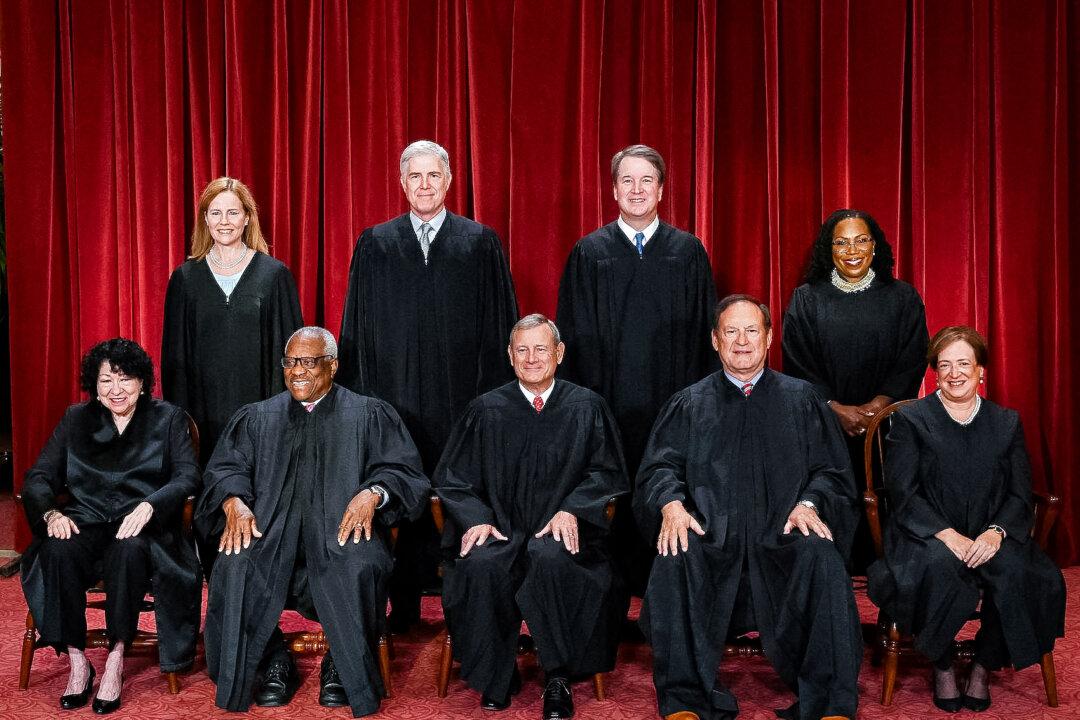The Supreme Court appeared skeptical of a challenge brought by a doctors’ group against the Food and Drug Administration’s (FDA) loosening of regulations of the abortion pill mifepristone.
In oral arguments on March 26, several justices seemed to question whether the doctors’ group had a right to bring the challenge, known in legal parlance as standing—a key argument in the government’s case.
The court heard oral arguments in two consolidated cases—Food and Drug Administration (FDA) v. Alliance for Hippocratic Medicine (AHM) and Danco Laboratories LLC v. AHM.
The AHM, a pro-life group, is represented by the Alliance for Defending Freedom (ADF). AHM’s website states that the consortium of medical organizations “upholds and promotes the fundamental principles of Hippocratic medicine.”
Medication abortions are reportedly lawful in 36 states and the District of Columbia.
A medication abortion generally involves the use of mifepristone, which blocks progesterone, a hormone, and misoprostol, which induces contractions. Misoprostol, which is widely available because it has many medical uses, isn’t an issue in the current litigation. Also known as mifeprex and RU-486, the drug is made by Danco Laboratories.
Advocates for mifepristone say the current system by which the drug is provided is safe, while opponents say it puts women at risk by ignoring safety measures that used to be in place.
The Biden administration and pro-abortion groups worry that the Supreme Court’s eventual decision in the case could affect the drug’s availability.
The Supreme Court case comes after Judge Matthew Kacsmaryk of the U.S. District Court for the Northern District of Texas, an appointee of President Donald Trump, held in April 2023 that the FDA was wrong to approve mifepristone for public use in 2000.
He said the FDA was under political pressure to get the pill on the market and then after that had deliberately dragged out judicial review of the drug for years. Judge Kacsmaryk found the FDA had improperly lifted restrictions related to accessing the drug and issued a preliminary nationwide injunction retroactively staying the FDA’s approval.
In 2016, the FDA changed the drug’s official label, extending the cutoff for use from 49 days of gestation to 70 days. At the same time, the agency allowed the drug to be prescribed with only one in-person visit and halted the requirement that prescribers report nonfatal adverse events.
In 2021, the agency allowed patients to receive the drug by mail instead of having to pick it up in person from a specially certified health care provider.
The U.S. Court of Appeals for the 5th Circuit refused to block most of the order, holding that the FDA’s actions in 2016 and 2021 were probably unlawful. The Supreme Court blocked the injunction over the original approval of the drug, allowing mifepristone to remain on the market, but pointedly refused to agree to commit to examining whether the original approval of the drug in 2000 was lawful.
During the March 26 hearing, much of the discussion focused on legal standing, that is, the connection a litigant has to a controversy before the court.
U.S. Solicitor General Elizabeth Prelogar told the Supreme Court that the Alliance for Hippocratic Medicine, whose member groups include physicians, lacks standing to challenge FDA regulations.
The agency has found the abortion pill to be “safe and effective” across five presidential administrations “and millions of Americans have used mifepristone to safely end their pregnancies.”
The other side “may not agree with that choice, but that doesn’t give them Article III standing or a legal basis to upend the regulatory scheme,” she said. Article III of the U.S. Constitution governs federal courts.
The AHM cannot rely “on a statistical theory of injury like the lower courts did,” she said. “Instead, they have to identify a specific doctor who faces imminent harm, but their theories rest on a long chain of remote contingencies.”
There are only “an exceptionally small number of women who suffer the kinds of serious complications that could trigger any need for emergency treatment,” she said. “It’s speculative that any of those women would seek care from the two specific doctors who asserted conscience injuries,” and any injury they might suffer cannot be traced to the regulatory changes of 2016 and 2021.
‘Grave Harm on Women’
Besides, doctors need not worry because they are already protected by existing law from having to participate in any procedure that violates their conscience, she said.The injunction entered in the case should be lifted because it harms the FDA, the pharmaceutical industry, and inflicts “grave harm on women across the nation,” Ms. Prelogar said.
Justice Samuel Alito pushed back, suggesting the government wanted to raise the standing bar so high that no one would be able to sue.
“Is there anybody who could challenge in court the lawfulness of what the FDA did here?” he said.
Ms. Prelogar replied, “In this particular case, I think the answer is no,” adding that even the states would be unable to sue.
The solicitor general also rejected a hypothetical from Justice Alito who asked if a woman who suffered adverse consequences from using mifepristone would be able to sue.
Although the doctrine of sovereign immunity would block such a case, “that’s a harder argument for us,” she said,
Justice Alito persisted, asking “Is there anybody who can sue and get a judicial ruling on whether what FDA did was lawful?”
The Supreme Court has held repeatedly that an absence of standing “doesn’t provide a basis to depart from Article III principles,” she said.
Growing exasperated, Justice Alito said, “So your argument is that it doesn’t matter if FDA flagrantly violated the law, it didn’t do what it should have done, endangered the health of women, it’s just too bad—nobody can sue in court?”
“The American people have no remedy for that?” he said.
Responding to Justice Amy Coney Barrett, Ms. Prelogar said the government “has been routinely resisting standing because we think that that would essentially mean that any advocacy organization could say it opposes what the federal government is doing and so therefore has to devote resources to that opposition.
“If that were enough, then every organization would have standing and it would be a vast expansion of ordinary Article III principles.”
Both Justices Clarence Thomas and Alito suggested that the federal Comstock Act, an obscure statute from 1873 that today is largely not enforced, needs to be considered. The law forbids the mailing of “indecent or immoral” materials, which some argue includes the abortion pill.
Justice Alito said the FDA should have “at least considered the application” of the statute to the case at hand.
Ms. Prelogar disagreed, saying the “Comstock provisions don’t fall within FDA’s lane.”
“I don’t think that it was FDA’s responsibility to consider that, nor could it have permissibly considered that under the statute.”
Justice Alito asked Danco attorney Jessica Ellsworth if the FDA is “infallible.”
“Has the FDA ever approved a drug and then pulled it after experience showed that it had a lot of really serious adverse consequences?”
Ms. Ellsworth acknowledged the agency “has certainly done that,” adding that the “adverse event reporting, the post-market surveillance that FDA does” help bring problems with drugs to light.
Justice Alito then asked if “the FDA should have continued to require reporting of non-fatal consequences” from mifepristone use.
Ms. Ellsworth said the FDA dropped that reporting requirement in 2016 “based on more than 15 years of a well-established safety profile” for mifepristone.
Justice Ketanji Brown Jackson asked Ms. Ellsworth if she was concerned that judges were “parsing medical and scientific studies.”
Ms. Ellsworth said the courts should not question FDA decisions because they are not qualified to do so.
In the case, “you have a district court that, among other things, relied on one study that was an analysis of anonymous blog posts. You have another set of studies that he relied on that were not in the administrative record and would never be because they post-date the FDA decisions here. They have since been retracted for lack of scientific rigor, and for misleading presentations of data,” she said.
“Those sorts of errors can infect judicial analyses precisely because judges … are not experts in statistics. They are not experts ... in the methodology used for scientific studies for clinical trials,” she said.
“That is why FDA has many hundreds of pages of analysis in the record of what the scientific data showed, and courts are just not in a position to parse through and second-guess that.”
AHM attorney Erin Hawley said that FDA regulations endanger women, effectively turning emergency rooms into “follow-up visits.”
Justice Barrett said first visits did not involve ultrasound and would not be able to give an “accurate gestational read on age or detect an ectopic pregnancy.”
“So why would the elimination of the visit necessarily increase the risks?” the justice asked.
Ms. Hawley replied that the FDA’s own data demonstrate that risk went up three-fold.
“Is that because doctors were voluntarily saying ‘Hey, let’s do an ultrasound,’ or try to detect a fetal heartbeat?” Justice Barrett asked.
Some justices suggested the district court ruling was too broad because it applied nationwide, instead of being limited to the parties in the lawsuit.
Justice Neil Gorsuch told Ms. Hawley this case “seems like a prime example of turning what could be a small lawsuit into a nationwide legislative assembly … on an FDA rule or any other federal government action.”
He also expressed concern over the growing popularity in the lower courts of injunctions that apply to the entire country, as opposed to the litigants alone.
There were “exactly zero universal injunctions that were issued during [President] Franklin Delano Roosevelt’s 12 years in office, pretty consequential ones. And over the last four years or so, the number is something like 60 and maybe more than that,” he said.
“They’re a relatively new thing. And you’re asking us to extend … and pursue this relatively new remedial course, which this court has never adopted itself,” the justice said.
The Supreme Court is expected to issue a ruling by the end of June.







